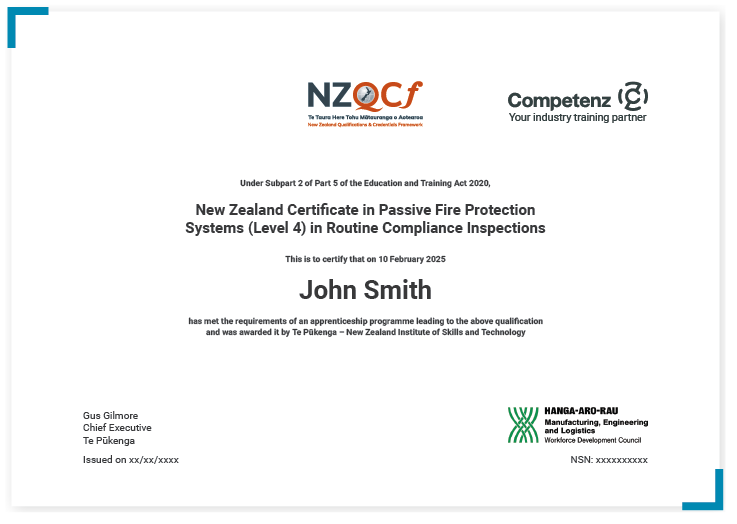
Apprentices learn in three main ways:
Together, these three learning methods prepare apprentices to meet the national industry standards for their trade or chosen strand.

A training agreement is the official document that sets up an apprenticeship. It is signed by the employer, the apprentice (also called the learner) and Competenz.
This agreement:
It also gives Competenz permission to access and share relevant information about the employer and the apprentice. This is important so we can support the training properly and meet national reporting requirements.
Signing the agreement means everyone understands their role in helping the apprentice build skills and succeed in the workplace.

The individual training plan outlines the structure for the apprenticeship. It is put together by the apprentice, Competenz training advisor and you, the employer.
It will include a variety of learning resources and assessment methods. The training plan is divided into a series of steps, made of a group of unit standards, each with an assessment that the apprentice must pass.
The order in which the apprentice does their learning is important. They need to learn the right things at the right time.
For example, we want to ensure that the apprentice has the relevant Health and Safety knowledge before applying it in the practical on-the-job units. We also need to make sure they understand the basics well before attempting the more advanced assessments.
Your training advisor will help order the plan to suit your workplace and the apprentice’s needs. From there, it’s about sticking to the plan and making steady progress.
Depending on the qualification, your apprentice may be required to attend block courses. Before they can attend a block course, they must complete all required pre-requisites.
For apprenticeships that include eLearning, apprentices receive an initial email with instructions on how to log in. Apprentices are also invited to an online induction which provides information on using the system and how eAssessments work. Once the unit is achieved, it will be archived. This means it’s still there when they need it, but it won’t get in the way of completing outstanding units.

All assessments are accessed through the eLearning platform. For any questions about using eLearning, please contact your training advisor first. If they are unavailable, you can email canvas.lms@competenz.org.nz.
Success in an apprenticeship doesn’t happen by accident—it takes planning and teamwork.
Apprentices need to commit to regular weekly study time to stay on track. Employers play a key role by providing support and staying in regular contact about how things are going.
Employers, if your workplace has a quiet room, consider making it available for study. This could be used before or after work. Or if you're open to it, during work time.. Just one dedicated study session each week can make a big difference.
Every apprenticeship has its own set of unit standards and credit requirements. The training plan will lay out what needs to be completed and when.
Your Competenz training advisor will help create a realistic study plan. With encouragement from the employer and commitment from the apprentice, it’s much easier to stay on track and make steady progress.
Competenz training advisors make regular in-person visits to check-in and review progress. We strongly encourage both the apprentice and employer to attend these visits together. When everyone’s on the same page, apprentices are more likely to stay on track and succeed in their training.
After each in-person visit, the Competenz training advisor will provide a visit summary report. This report outlines:
We encourage apprentices and employers to go over the report together. It’s a good moment to celebrate progress, spot anything that needs attention, and reset goals if needed.
Between visits, you can also check progress online. Just log in to Competenz Central and open eServices. If you don’t have access yet, your training advisor can help you set it up.
Assessment is a team effort. Several people support the apprentice along the way:
Verifiers are usually supervisors or team leaders in the workplace. They watch the apprentice perform a task and confirm it was done to the right standard. Verifiers don’t make the final call — they simply sign off that the apprentice is ready to be assessed.
Assessors are trained professionals who review the apprentice’s work. They look at written answers, reports or practical evidence and decide if it meets the standard. Their role is to make sure assessments are fair, consistent, and meet national requirements. In most cases, your training advisor is also your assessor.
eAssessors mark assessments completed through the eLearning platform. They check the work against the unit standard and decide whether the apprentice is ‘competent’ or ‘not yet competent.’ eAssessors also give feedback and guidance if something isn’t clear or correct.
Registered Workplace Assessors (RWAs) are based in the workplace and have been trained and approved by Competenz. They can both verify and assess tasks on site. Not every workplace has one. If your workplace doesn’t have one, the training advisor will arrange for someone else to do the assessment.
Assessments are how we check what apprentices have learned and can do.
Some assessments are like quizzes — they test knowledge through written questions or online answers. Others ask the apprentices to do a practical task that is verified or for somebody qualified to observe them performing a task. Sometimes, it’s a mix of both.
Every assessment comes with a guide which explains what needs to be done.
Once the work is submitted, a trained assessor will review it. They’ll check that it meets the requirements and provide clear, helpful feedback.
The apprentice then works through this feedback until they’ve met all the requirements — both written and practical.
Every assessment guide includes clear instructions on:
It’s important to read it carefully and follow the instructions. Incomplete submissions cause unnecessary delays and interruptions to the assessment process.
If the apprenticeship includes eLearning, all assessment guides will be available through the eLearning platform.
The Competenz training advisor will work with the apprentice to agree on which unit standards to focus on and set goals for when assessments should be completed.
On-the-job assessments are downloaded, printed, and completed by the apprentice. These must then be observed and verified by their workplace supervisor.
Once completed, the assessment is submitted to a Competenz assessor — usually the training advisor — who will mark the assessment and provide feedback.
For some assessments, apprentices are asked to provide photos as supporting evidence. They need to read the requirements carefully to find out exactly what is expected and what photos to take.
It’s important to be disciplined with collecting the required evidence from day one. If an apprentice is storing photos on their phone, they need to download and back them up regularly. We encourage apprentices and employers to regularly check and review the saved photos together. This helps keep on-the-job learning on track.
The apprentice learner guide provides apprentices with best practice guidance.
If the apprenticeship includes eLearning, apprentices can complete open-book online assessments. Most answers can be found in the learning materials, though some questions may require extra research.
There are two types of online assessments:
Employers and apprentices can work together to avoid common mistakes that delay progress. Before starting an eAssessment, apprentices should:
If the assessment includes both types of questions, the results from the machine-marked section are shown first.
Apprentices must submit completed assessments, with required evidence and signatures, by email or directly to their training advisor.
For eLearning assessments, apprentices submit their work directly through the eLearning platform.
All assessments must be the apprentice’s own work. Being honest about what’s been done and who helped is part of building trust — and making sure the qualification means something. Using copied or AI answers takes away from real learning and could delay progress in the programme.
The assessor will explain which questions were not answered correctly. They’ll give guidance on what needs to be improved and point out where to find more help. It’s important to read all feedback carefully and focus only on the questions identified by the assessor. Only the questions or sections identified in the feedback need to be updated and resubmitted. There’s no need to resend the entire assessment — just the parts that needed correcting.
Learning by doing means we don’t always get things right the first time. That’s part of the process. Apprentices may need to revisit their work, apply feedback and try again until it all makes sense — and that’s okay.
Employers play a big role in this. By encouraging and supporting apprentices as they build confidence and knowledge, you help them grow into capable, skilled workers.
Assessments are only considered complete once everything is correct — all questions are answered and all practical tasks are marked as competent.
Encourage your apprentices to bring their on-the-job assessments into team spaces like the staffroom. Talking through the tasks in a relaxed setting helps apprentices learn and gives qualified tradespeople a chance to share their skills and experience. These conversations can also benefit the wider team by encouraging knowledge-sharing and fresh thinking.
Where textbooks are part of an apprenticeship programme, they will be provided to support both theory and practical learning. These resources help reinforce key concepts and complement the training that happens on-the-job.
Textbooks for this apprenticeship are listed in the apprenticeship details and training plan.
Everyone learns differently, and apprentices aren't expected to know everything from day one. What matters is that they know where to go when they need help – beyond what’s available in the workplace.
Competenz offers a range of support options to help learners achieve success. One of the most important is the training advisor, who works closely with both the apprentice and their employer throughout the apprenticeship.
Training advisors visit regularly to:
Between visits, apprentices can contact their training advisor by phone or email at any time they need advice or support. Encourage your apprentice to reach out – they’re not alone in this journey.
If an apprenticeship includes online learning and your apprentice doesn’t have access to a computer, we can lend them a Chromebook so they can complete their studies. Just talk to your training advisor to arrange one.
What happens if an apprentice needs help with eLearning or is stuck on a question?
Call 0800 526 1800 (and press 4) on Tuesdays, Wednesdays, and Thursdays between 5pm and 8pm to talk to one of our eAssessors. They are here to help.
Online study groups are available to support learning and connect apprentices with others on a similar journey. These sessions are usually held fortnightly during the week and run for two hours.
Each session is led by experienced experts who can help with assessment questions and provide study tips. It’s a valuable opportunity for apprentices to bring along specific questions and get advice in real-time. To make the most of the experience, apprentices are encouraged to set clear goals and actively participate.
Once enrolled, regular attendance is expected unless the apprentice is unwell or has been given leave of absence by a manager due to work demand. Competenz encourages employers to support participation in study groups and factor them into work planning wherever possible.
It’s good practice to check in regularly with the apprentice about their progress in the study group and what they’re working on. Enrolment and session details can be arranged through your Competenz training advisor.
Everyone learns differently—and sometimes reading, writing, or maths can get in the way of progress at work or in training.
Competenz partners with expert tutors to make sure support is available when it’s needed. This might be for someone new to the workforce, or for those who find certain learning tasks more challenging.
Support available includes:
This kind of support can reduce mistakes, boost confidence and improve on-the-job communication. If someone avoids taking responsibility, repeats the same errors, or hesitates to ask questions, it could be a sign they need extra help with literacy or numeracy.
With the right support, these challenges can be overcome—unlocking talent and lifting productivity. To learn more, contact your Competenz training advisor, or email learnersupport@competenz.org.nz.
At the start of the programme, apprentices complete a short literacy and numeracy assessment—either online or on paper. This helps identify strengths and highlight areas where extra support could be useful. It ensures that learning remains accessible and progress stays on track.
Dyslexia doesn’t affect intelligence, but it can make reading, writing, and working with symbols more difficult. Competenz offers a free online screening tool to help identify where support may be needed. Our dyslexia support includes tools and technology to assist with learning and assessments.
To access this support, the apprentice will need complete a quick online ‘QuickScreen’ assessment. We’ll manage the application with Workbridge and help arrange access to the right resources.
Financial literacy is about making confident money decisions—both day-to-day and for the future. It can help with reaching personal goals, supporting whānau, managing income and planning ahead.
Competenz connects apprentices with trusted tools and resources from the Commission for Financial Capability. These resources are designed to build confidence managing money and practical skills that support long-term wellbeing.
As part of our ongoing commitment to supporting healthy learning environments, we are ensuring that all apprentices have access to mental health and wellbeing resources.
Competenz now offers learners access to free counselling through our provider Vitae.
Through this service, learners are able to access free confidential counselling, with their choice of counsellor. A 24/7 contact centre and duty counsellor are also available for emergencies.
Completing an apprenticeship is a major milestone. It reflects the development of real-world skills, the meeting of industry standards and the successful achievement of a nationally recognised qualification.
Once the programme is complete, an official certificate is issued to confirm the qualification. This is either presented in person by a Competenz training advisor or couriered directly to the workplace.
This achievement is something to be proud of. It represents not just personal commitment and hard work, but also the support of the workplace, whānau and those who contributed along the way.

